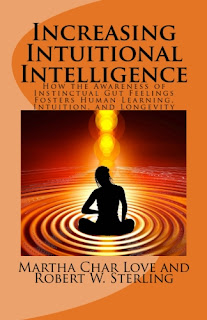=10-30-11.25748&scores=75&search_type=&yes=62) as it fills in the data needed to understand our scientific investigation and research on the gut responses and instinctual human somatic responses. All copyrights of this article are reserved for Somatics Magazine and the author, Silver Love. Permission is given to viewers by the author to make a copy of this article for educational purposes only (that is anyone who wants to read it and learn from it) and all material used must be accredited to her authorship. Also note that both the research and findings at SSU on the Somatic Reflection Process are included in this article, as well as a protocol for facilitating the Somatic Reflection Process to access gut responses and provide the healing of trauma and to promote good health. A printable copy is also published on http://careerstorefront.angelfire.com/somatics2.html.
Healing the Trauma of the Body/Mind Split through Accessing Instinctual Gut Feelings: A Protocol for Facilitating the Somatic Reflection Process (SRP)
By Silver (M.C.) Love, MA, MA, PMA.
To my surprise last spring, an article titled “Gut Almighty”, which briefly explained the latest emotion theories on how intuition comes from the gut, was featured in Psychology Today (Flora, 2007) at the same time that my article on gut instinctual somatic responses and healthy life choices was published in Somatics Spring 07 issue (Love, 2007). I wondered if two articles published on the gut in one month might surely be a record, as the gut has not seemed to have so much attention in the media since Gershon’s (1998) book acclaiming it through his neurological research to have a mind of its own.
In the months I awaited the publication of my article, I reread Gershon’s (1998) book and it was again delightful to me to read that a scientific investigation actually uncovered evidence that the gut has a separate capacity to generate and record vital responses and functions as what he calls our second brain. Gershon outlines the biological functions of the gut as being its own intelligent brain and having its own vitality that is in communication with, but not dependent upon, the head brain. As I combed through his book and shared emails with my colleague, Robert Sterling, it became quite clear to us that Gershon’s work was supportive of the clinical findings in the work we did as guidance counselors in the 70’s. Our work centered around assisting people to assess the meaning of their experiences through an awareness on the empty-full instinctual feeling responses that they identified in the gut region of the body. We found with the people that we counseled that these gut responses were linked to the dynamic struggles of balancing the two needs of the person for acceptance and for feeling in control of one’s own responses (the freedom to respond naturally), and that these two needs were instinctual and necessary to fulfill on a moment to moment basis for continued vitality of the person. Similar to Gershon’s findings, it was also our conclusion that the gut area of the body contains a feeling response center that holds a relationship to the thinking processes of the person, but is a separate response center from the thinking head responses and certainly not dependent upon it.
Feeling inspired by Gershon’s (1998) work and the attention recently given to the gut in the literature and media, I decided to write a second article for Somatics that further explains the specific technique of the Somatic Reflection Process (SRP). The intention of this article is to answer the questions about the process that I have been asked in the past year by many friends and colleagues who read my first article last Spring on the findings of Robert Sterling’s and my somatic work as guidance counselors. I am including both the method and a protocol for facilitating the SRP, as well as a brief summary of a recent research study using the SRP protocol presented (Love, 2005).
Click on a book cover below to go to Amazon to Buy:
"Increasing Intuitional Intelligence" is available on Amazon USA and Amazon UK
If
you are on the homepage of this blog, click word "comment" directly
below to see all comments and make one yourself! If you are on the
webpage for this post, then simply post in the box provided below.




